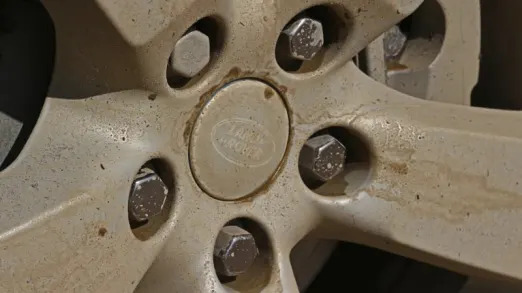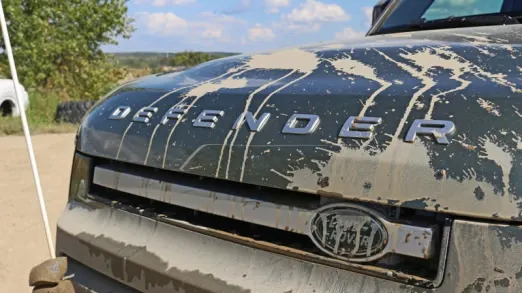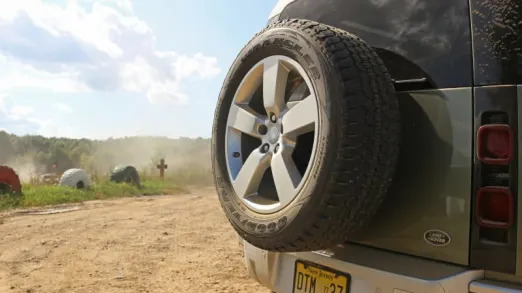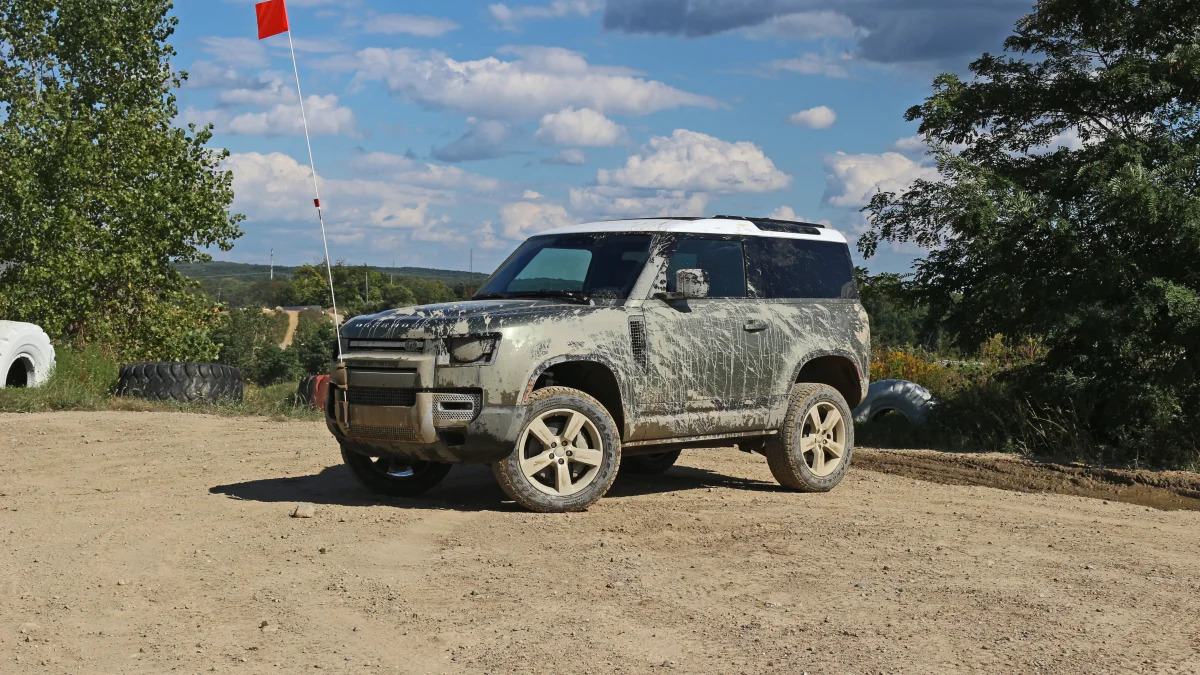For Land Rover fans, the availability of the short-wheelbase Defender 90 model has been a long time coming. I got a chance to sample one for a brief, on-road drive earlier this year, but it was just recently that Autoblog was offered a second crack at the revived 4x4 nameplate, this time in a more appropriate environment.
With summer winding down in southeast Michigan, I was pleased to be offered the opportunity to take the short-wheelbase, two-door 90 out for a little fun in the dirt. As usual, my venue of choice was Holly Oaks ORV Park, located about 20 miles north of downtown Detroit on I-75.
Built on the now-depleted section of an old sand and gravel plant, Holly Oaks has a little bit of everything, from natural elevation change and dirt/mud obstacles, to carefully placed rock complexes designed to put off-road rigs to the test, be they stock or heavily modified. There are even some high-speed courses set up for those who prefer a little taste of Baja over the slower pace of rock crawling.
When it comes to a nameplate like Defender, there’s little question when it comes to capability. Bombing along a desert trail and slowly threading obstacles in 4-Lo are both solidly in its wheelhouse. But a two-door model like the 90 leans tight and technical, rather than fast and fluid, largely due to the short wheelbase. What it gains in maneuverability, it sacrifices in high-speed stability and comfort.
With that in mind, I started slow. As a proper off-roader should, the Defender 90 First Edition comes standard with all-terrain tires (albeit on 20-inch wheels, but at least they weren’t accompanied by low-hanging side pipes). Aired down for a little extra cushion, I set the D90’s air suspension to its off-road height and started off with some traction tests.
Climbing loose sand hills in 4-Hi without the rear differential locked proved just how far modern traction-control systems have come. Even after bogging down, the Defender’s computers were able to sort out a few precariously soft uphill stretches with nothing more than a stern (but judicious) ramp-up of throttle.


Naturally, locking the rear differential rendered the same sections entirely trivial. It also meant I could be quite a bit less ebullient with the right pedal and keep my speed down a bit more without having to worry about sacrificing momentum. But when it comes to the really technical stuff, there’s no substitute for a low range.
Parts of the park not frequented by dirt bike and ATV traffic can be quite desolate, and those that would require a fairly well-equipped off-roader to tackle even with the benefit of a spotter tend to be even quieter still. The muddy track along the far end of the park, meant as a bypass for some of its tougher break-over obstacles, is one such section, especially in the heat of the summer when its entrance is often grown over with bushes that make it appear more narrow than it really is.
With this claustrophobic thicket clawing out for the Defender’s Pangea Green paint finish, I made use of the short wheelbase to keep the foliage (and the hard-packed, stone-riddled dirt hidden behind it) at bay as I meticulously threaded my way around to my destination: a series of dips and gullies with little drainage fed by a summer’s worth of rainwater. Yep, you guessed it. Mud.
While the Defender does come with all-terrains, we’re talking about a set of relatively basic Goodyear Wranglers. They’re not bad, but neither are they meant for severe duty. If you’ve never encountered the sort of mud that lurks around an old gravel pit, think back to the slick, sludgy goop that accumulated on your grade school art teacher’s finger nails. It might as well be grease. Fortunately, Land Rover’s Terrain Response system makes choosing the right mode for a given surface quite simple. With the Defender in 4-Lo and the drive mode dialed over to “Mud,” I ventured in.
To do so required clearing a decent-sized hump, which the short-wheelbase Defender 90 had no trouble doing. From there until the next dry spot, momentum was the name of the game, but only to a point. Go too slow, and I might bog down; too fast, and I might eat the next climb-out ramp with the Defender’s low-hanging front aero dam. Each successive gully revealed itself to be wider, wetter and seemingly even more untouched than the last, and yet each was dispatched with little drama. Only the final hump even squeaked against the Land Rover’s underbody protection, and the following wash sent muddy rooster tails over its roof, but keeping momentum up never proved challenging.
From there, I sought out some hard-packed, scratchy dirt surfaces to help un-pack the tires’ void spots. With them properly cleared, I faced a downhill trek back toward the remainder of the park. Three paths down lay before me; the first one I chose appeared to lead nowhere, prompting a reversal; the second seemed to wander off into a maintenance area. A third appeared, at least at first blush, to be a winner. I was wrong.
And I figured that out the not-so-fun way when my slow, downhill creep gave way to sliding and shuffling just as I passed the midway point. I managed to scrub off momentum and get the Defender stopped about 15 feet short of the bottom, which I could now see was heavily rutted from recent rains, to the point where I was concerned I might not be able to put a tire somewhere that would keep the Land Rover’s nose from planting straight into the dirt at the base of the descent.
For want of a spotter, and fearing again for the Defender’s low-hanging front plastic bits, I decided that discretion was the better part of valor. This presented a bit of a pickle. Coming down that last 50 feet was treacherous enough; would I have enough grip to do it in reverse? Keep in mind, the alternative was not merely being stuck in place; losing grip attempting to climb the hill backward would likely mean a repeat of my previous downward shuffle toward what I firmly believed would be an abrupt, crunchy and, above all else, expensive stop. And you think your job is stressful.
Though I’m sure it was unnecessary due to the Land Rover’s electronically controlled brake system, I nevertheless moved my left foot over to the brake before dropping the Defender into reverse. It remained obediently stationary as I eased onto the throttle and slowly lifted off the stoppers. At first, nothing happened. Then, with just a hint of shudder, the rotors slipped free at each corner and the Defender began to ease backward up the hill. I breathed on the throttle, the scrub on either side of the trail moving forward in my peripheral vision with increasing swiftness. And then I was clear, back atop the ridge, with plenty of room to maneuver – and self-imposed permission to continue breathing.
My caution was validated when I passed the lower entrance to that hill and saw the nearly two-foot vertical drop-off at its base. Doable with the right car and an experienced spotter’s help? Absolutely. In a stock Defender with no outside eyes? That’s the sort of gamble that usually ends with a flatbed. Oh, and the path that I initially discounted as going nowhere? Yeah. It emptied right next door. Go figure.
Normally, I’d say it was all downhill from there, but that metaphor doesn’t quite work in this context. I wove my way back to the front of the park to give the Defender a shot at Holly Glen – one of the park’s higher-speed courses, and the one best-suited to cars and trucks, rather than dirt bikes.
You might recall that I took a Mercedes-AMG G63 around this same course only weeks ago and absolutely loved it, but the thing about off-road venues is that they change. Whether year-by-year or minute-by-minute, even carefully manicured trails are never the same twice. Unfortunately, the recent weather washed much of the soft sand off of the Glen, leaving it hard-packed and rutted.


Luxurious though a Land Rover may be, a short-wheelbase SUV with the suspension firmed up becomes a tippy, erratic dance partner in such an environment. Concerns over bending wheels and bruising internal organs prompted me to cut the outing short after just a couple modestly quick laps; I’m keen to revisit this with a long-wheelbase V8 model when it makes its way stateside.
On my way out of the park, I happened upon a gentleman driving his young family around the park in a brand-new Jeep Wrangler 4xe. I eased up next to him for a chat, asking how he was liking his hybrid; he confessed that he’d actually cross-shopped it with a Defender, but ultimately ended up buying the Jeep because, well, he could. This raises an important point: availability.
Though not quite as thin on the ground as the 2021 Ford Bronco, the new Defender remains difficult to acquire, especially in short-wheelbase form. Is it better than the Bronco or aforementioned Wrangler? Yes, in quite a few ways. It’s certainly much more comfortable on the highway and offers significantly more cabin refinement, but its interior is still cramped by luxury SUV standards, and the short-wheelbase Defender 90 offers what could best be described as a truck-like response to potholes and other sharp impacts.
At its base price of just under $50,000, the Defender 90 doesn’t enjoy the exospheric premium of the aforementioned G63. While it’s still nontrivially more expensive than the mass-market offerings from Ford and Jeep, the gap between it and a $43,000 Wrangler Rubicon or Bronco Badlands isn’t quite so dramatic. If you feel the Defender’s unibody refinement or its premium image justify the added cost, frankly, I won’t argue, but keep in mind that goodies like our tester’s multi-height air suspension aren’t free; our First Edition rang the till at $66,475 after destination.
With my money, I’m probably optioning up a Wrangler 4xe, but then Land Rover doesn’t claim to be the best value. Rugged, yet refined; capable, yet coddling? With its splash of British pretension that stops just short of ostentation, the Defender is a disarmingly aloof off-roader that carries just a hint of old-world sophistication without being afraid to get dirty. I can dig that.
Related video:











Sign in to post
Please sign in to leave a comment.
Continue